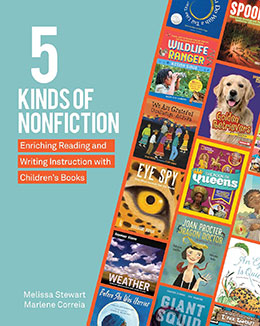5 Kinds of Nonfiction
Enriching Reading and Writing Instruction with Children’s Books

by Melissa Stewart
and Marlene Correia
Routledge, 2021
for Grades K to 8
ISBN 978–1‑62531–417‑8
In the U.S., available for purchase through the publisher, Permabound, Booksource, Mackin, your local independent bookseller, or Amazon.
In Canada, Pembroke Publishers or Amazon. In Europe, Amazon or Eurospan. In Asia or Latin America, Eurospan. In Australia/New Zealand, Hawker-Brownlow.
Nonfiction for children has undergone exciting changes in recent years, evolving into a new breed of visually dynamic, engaging texts that delight as well as inform. The timing of these groundbreaking changes couldn’t be better, as ELA standards put an increased focus on nonfiction reading and writing. As a result, finely crafted nonfiction children’s books are ideally suited for augmenting content area curricula, serving as reliable resources for research projects, acting as mentor texts for writing workshop and, as always, serving as a great source for pleasure reading.
In 5 Kinds of Nonfiction: Enriching Reading and Writing Instruction with Children’s Books, present a simple, practical system for sorting nonfiction into five major categories (active, browseable, traditional, expository literature, and narrative) and describe how classifying books in this way can help teachers and students effectively utilize the books in a school setting. Along the way, they:
- explore each of the categories through discussions, classroom examples, and insights from leading children’s book authors
- offer tips for building strong, diverse classroom and library collections
provide more than 20 small group, whole-class, and whole-school activities to enhance literacy instruction - include innovative strategies for sharing and celebrating nonfiction with students
With more than 150 exemplary nonfiction book recommendations and Stewart and Correia’s extensive knowledge of literacy instruction, 5 Kinds of Nonfiction will elevate your understanding of nonfiction in ways that speak specifically to the info-kids in your classrooms, but will inspire all readers and writers.
Resources
PODCAST: “Enriching Reading and Writing Instruction with Children’s Books,” with Melissa Stewart and Marlene Correia, hosted by Stenhouse Teacher’s Corner

Reviews
“Stewart asks children to imagine approaching a towering tree with a hole in its trunk that’s large enough for them to slip inside. What if they lived there? How would it feel? This picture book introduces 15 animals living in tree holes that they have either found or made for themselves and their young. Hevron’s stylized illustrations—digital collages of acrylics and markers on wood—depict the critters and their homes using a limited but effective range of colors. A useful addition to classroom units on animal homes.” (School Library Journal)
“Thinking outside the nest, here’s a gallery of arboreal residents, from tree frogs to birds and bobcats. Stewart invites readers to join her in visualizing some of the animal residents known to use hollowed-out spaces in tree trunks and imagining what such a home would be like… Hevron creates intimate close-ups of stylized but easily recognizable creatures peering out or in cross-sectional views nestling down… A lofty mix of nature facts and rumination.” (Kirkus Reviews)
“A beautifully written and illustrated picture book about tree holes and the creatures who inhabit them. The unique illustrations bring the text to life!” (KIDS Bookshelf)
Behind the Book
“The idea for this book traces all the way back to the summer between third and fourth grade, when I read My Side of the Mountain by Jean Craighead George. Oh, how I longed to live off the land and make a hollow tree my home, just like the main character, Sam.
“Time passed, and I forgot about the book until a trip to Vancouver Island, British Columbia, Canada, in 2011. The instant I spotted a tree with a hole big enough for me to squeeze inside, Sam’s story came rushing back. And as I stood inside and looked up into the hollow tree, I knew I’d write a book about tree hole homes.
“I created a file on my computer and added information from my nature journals. Whenever I read or heard anything about tree holes or animals that live in them, I added more notes to the file. Eventually, I knew I had enough information, but I didn’t know how to structure the book or how it should begin or end. I was stuck.
“But then in 2018, while hiking in Topsfield, Massachusetts, I stumbled upon another large tree hole. As I awoke the next morning, the beginning of the book popped into my mind.
“I ran to my office, and as I wrote it down, the ‘opposites’ text structure came to me. Using index cards and sticky notes, I mapped out the book in just a few days. Then it was time to start writing.”

by Melissa Stewart
and Marlene Correia
Routledge, 2021
for Grades K to 8
ISBN 978–1‑62531–417‑8
In the U.S., available for purchase through the publisher, Permabound, Booksource, Mackin, your local independent bookseller, or Amazon.
In Canada, Pembroke Publishers or Amazon. In Europe, Amazon or Eurospan. In Asia or Latin America, Eurospan. In Australia/New Zealand, Hawker-Brownlow.
Book Extensions
5 KINDS OF NONFICTION
ANCHOR CHART
USING THE 5 KINDS OF NONFICTION TO TEACH CRAFT MOVES
5 KINDS OF NONFICTION AND STUDENT PURPOSE
INVESTIGATING NONFICTION LIKE A DETECTIVE
EXPLORING ACTIVE NONFICTION
(with Chocolate Chip Cookies)
BOOK MATCH SURVEY
(Perfect for the
beginning of the school year)
You’ll Also Enjoy



